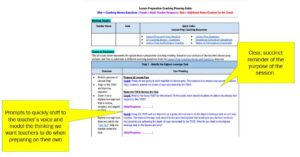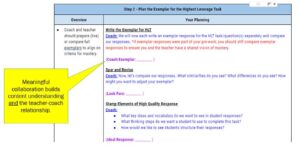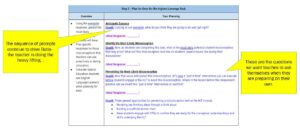02.14.24The Protocol Paradox: Scaling Effectiveness and Authenticity at Harmony Public Schools
This is the second of four posts on the challenges of achieving lasting change in instructional leadership at-scale via professional development. The series is based on our work with Harmony Public Schools in Texas. In this post Dan Cotton and Dillon Fisher address an important theme: that consistency is necessary to success at-scale and, perhaps unexpectedly, can also enhance authenticity.

Harmony colleagues–teacher and coach–at work.
In our first post, we gave an overview of lessons learned from our 30 month partnership with Harmony Public Schools. A central element was building the coaching capacity and curriculum systems to execute Lesson Preparation across Harmony’s 60 campuses.
Scaling invites a challenge. In the drive to execute a clear, consistent vision for Lesson Preparation across many leaders, must an organization sacrifice authenticity and genuine relationships in coaching conversations? We think the lesson from Harmony–counterintuitively–is no. Consistency actually can enhance authenticity.
The Need for Consistency
Harmony serves 46,000+ students through a staff of over 5,000 employees. 300 of those are instructional leaders whose development we supported through our partnership. As Harmony began to build a culture of Lesson Preparation, the need for consistency became clear. Michael Dies, a District Instructional coach (and the creator of the guide featured below) described the challenge:
“Before the lesson prep coaching structure…each district coach would try to support teachers with lesson planning and preparation, but every coach had a different approach. With everyone approaching this coaching support differently, it was hard for coaches to collaborate on resource creation, it was hard for coaches to reflect and give one another actionable feedback, and it was hard to train teachers on how to best tackle this work on their own outside of a coaching meeting.”
As Michael illuminates, when all coaches were approaching lesson preparation uniquely, there was no practical way to learn from who was being most effective, to support each other efficiently, and to replicate success reliably.
When a school system decides to invest in instructional coaching–whether it’s Lesson Prep, observation and feedback, or student-work/data analysis– it must commit to providing clarity about what the intended outcome of a coaching session is, and how that looks and sounds during each step. The importance of clarity is particularly acute for large organizations who (through growth and/or turnover) face the need to replicate success with significant numbers of new leaders and teachers. When the vision is clear, coaching can be effective at-scale.
One of Harmony’s solutions to scaling consistency is its Lesson Prep Coaching Planning Guide (SY24). The coaching guide translates Harmony’s vision into replicable leader actions, enabling all leaders (particularly those new to the role) to have a meaningful impact on the quality of teachers’ lesson execution.



As the full guide and the annotated images above show, the strengths of this guide were multi-faceted: leaders had a clear understanding of the shared outcome of Lesson Preparation meetings, teachers and leaders experienced a consistent structure that valued teacher-time and, most importantly, the structure reliably led teachers to feel more confident and better prepared for their upcoming lessons.
The Protocol Paradox
One of our worries as we worked through iterations of the coaching guide alongside Harmony’s leaders was the possibility that systemizing Harmony’s approach to Lesson Preparation, especially through scripted leader prompts, might inhibit authentic coaching. Would consistent language leave teachers feeling that their development was on “auto-pilot?” Would these meetings unintentionally feel robotic and strip away a necessary authenticity to leader-teacher relationships? Would coaches be responsive to teacher ideas and the nuances of content? As we studied Lesson Preparation meetings alongside Harmony leaders, we found the opposite: Consistency actually enhanced authenticity. Two reasons we think that’s true:
- Consistency Frees Up Working Memory: With the Lesson Preparation Guide in hand, leaders were able to focus more on the most effective process of Lesson Preparation and less on determining how to support their teachers or transition from one component to the next. Leaders and teachers knew what to expect and thus were able to spend their working memory digging more deeply into the lesson itself: What will excellence on the key task look and sound like? Why? Where might my individual students get stuck and how can I support them? How will students engage with the content individually and with their peers?
- Consistency Enables Better Listening: Similarly, without having to worry about what to say next or how to word it clearly, the Lesson Preparation Guide freed leaders’ working memory (as we know from the cognitive science research) to truly listen, and thus respond, to the ideas, questions, and challenges of the educator in front of them. In the countless videos we studied, we watched leaders and teachers spar on ideas about essay organization, laugh warmly through different attempts to resolve imagined misconceptions, and engage freely in practice that supported clarity for students.
Rather than degrading collaboration, systematizing lesson preparation with a clear protocol, including scripted prompts, actually accelerated it.
A consistent protocol benefited not just the individual teacher-coach conversations, but enhanced collaboration among leaders: Leaders could study video of colleagues executing the same protocol they use, peers and supervisors could give more targeted feedback that accelerated leader growth, and Harmony had greater clarity into how lesson preparation impacted teacher delivery of lessons.
Harmony continues to make responsive adjustments to its Lesson Prep protocol but the essential framework remains consistent. Such consistency–of common language, of approach, of expectations–advances leader development, teacher development and ultimately student engagement and success.